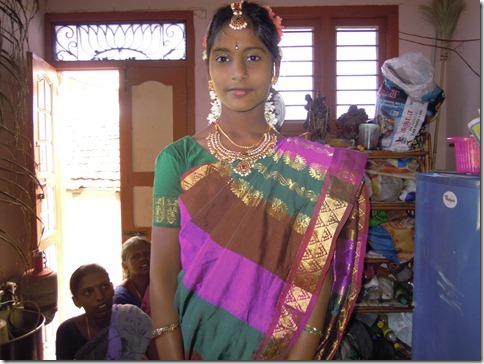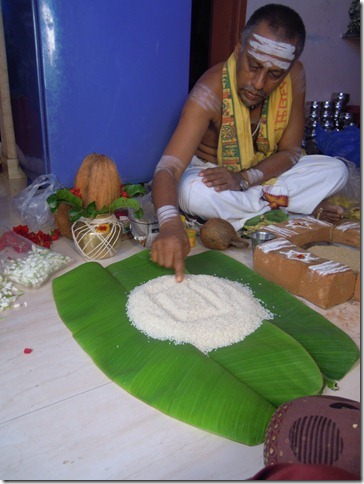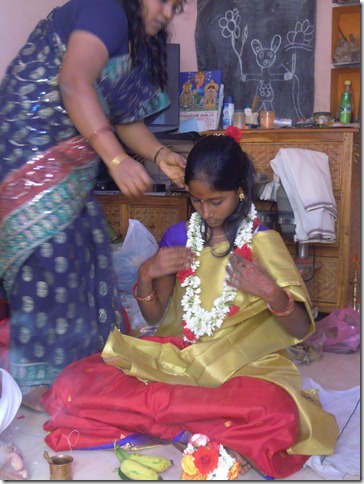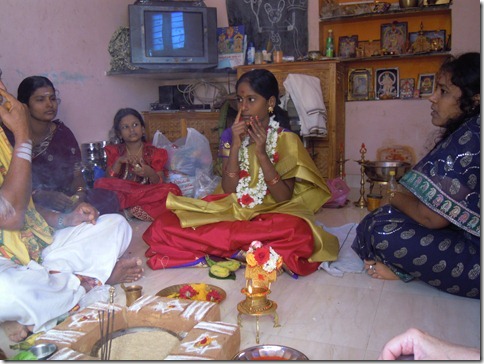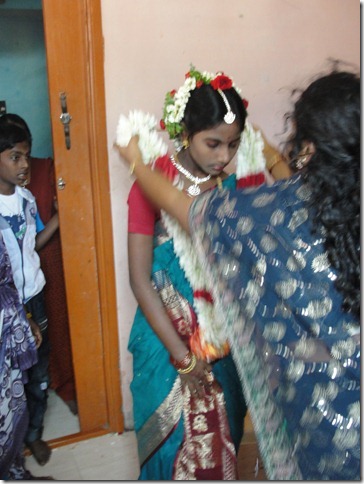It is very important in Tamil culture when a girl has her first menstrual cycle. This is the time when she becomes a woman, a major step in a girl’s coming of age. At this time, for the girl and her family, this is one of the most important of life’s rites of passage. This is the Tamil Manjal Neerattu Vizha (“Turmeric Bathing Ceremony”).
In 2009, I wrote about one such function, shown in this post. The earlier post showed the Manjal Neerattu Vizha, as a big public event. This present report shows it as a small and close family (and close friends) event. I have to say, after being to both types, that I like the small family event more. This is what will be shown in this post, below.
First Menstrual Cycle
The girl is Jananee, the daughter of Rajan, our rickshaw driver, general helper, and friend.
This all started on 14 December, 2012, when we received an urgent call from Rajan saying that his daughter had her first period, and wondering when Carol was going to go see her. We knew that this would be coming someday, and that this is a big deal for the girl and her family, but we did not expect it now. Jananee just turned 13, and Indian girls usually have their first menstrual cycle at 14, so this is a bit early. We still didn’t think much of the call until we got another call from Rajan, asking again if Carol was going to see his daughter. After this we knew that to Rajan (and probably his family) it was important that Carol go see her.
So soon afterward we hopped on my motor scooter and went off for a visit. Carol went in and I went down the street to do something else for a bit. When Carol came out she said that all of the Aunties were there with Jananee and her mother, Janakee. Jananee was kind of huddled, squatting in a place outside the house. She had to be immediately removed from the house, because she was now seen as unclean. Carol went over to hug her, as she would have hugged her own daughter under these circumstances. But all the Aunties said, urgently, “No!” The young girl, now becoming a woman, was unclean. She was forbidden to touch other people until, in a few days, she would have her Manjal Neerattu Vizha.
So for this time period, Jananee had to be separated from everyone, could not touch or be touched, and had other restrictions.
The ladies, who spoke no English, were asking Carol about something, but Carol could not understand. We learned later that they were asking Carol to go with them to eat out at a restaurant, very unusual for this family. All the family women were going to go out and eat with Jananee. Rajan said the meal would be to celebrate “Age Attained.” Maybe one reason for this eating out this day was that they considered food prepared in an “unclean” house to be bad. I heard Janakee say that she could not cook food now, since it would not taste good, and would not be nourishing.
The Ritual Separation
In a well-off family, or in a village, they might build a small thatched hut (kudsai) for the separation time. Rajan’s family is pretty poor, so they could not afford such a structure. They ended up creating a “seclusion area” in the front room of their home, where Jananee stayed behind a coconut leaf for the duration. She would sit there during the day, eat there and sleep there. Until she was purified by the Manjal Neerattu Vizha.
These menstrual huts are common throughout the world in tribal cultures. The deep reason for this is not that the girl is unclean, but rather that she has so much feminine power now that she might accidently destroy the village.
I visited two days later, on 16 Dec., and found Jananee behind the coconut frond. After the day of the first period, she has nine more days that she must stay here. She will not go to school. She will live in the small space, sleep, and take all her meals on plates that stay with her in her “hut,” leaving it only for her ritual bath each morning before the sun rises. (Her mom got her up each day at 5 AM for her daily bath.)
Below, you can see her in her ritual ‘kudsai’, standing behind the coconut leaf. She is wearing new clothes and jewelry (the likes of which I had never seen on her before). When I visited, the house was filled with woman of the family, Aunties. Everybody was so happy. When I looked closely at Jananee, I saw that she was wearing makeup on her eyes. I think her Aunties had made her up.
During this time she must carry with her at all times a leaf from a Neem tree, and a small piece of charcoal. The other thing she must do is to always have turmeric powder on her face.
I had to go out of town, and gave Rajan my camera, so he could take more photos. I had understood from the Aunties that Jananee would be dressing up in different clothes over the next few days, and I wanted to make sure we had photos.
Below is Jananee on the third day of her seclusion, dressed in another set of clothes, with a special head jewelry and many bangles. The yellow outer garment is a “half-saree.” The half-saree can only be worn by women who are not married. If you have ever watched an Indian movie, there was probably a leading lady, the love interest of the hero, and the girl with whom he would dance and sing, a young woman wearing a half-saree. The half-saree is like a public announcement, “Here is a young woman available for marriage.” The half-saree is worn over a blouse and long skirt of some kind.
Close up of Jananee. Her father had her take this pensive pose.
One of the Aunties, Great-aunt Parvathi, who was here for the seclusion period. This is Rajan’s aunt, his father’s sister.
The next day, the fourth day, 18 Dec., Jananee is wearing a very fancy set of clothes and jewelry borrowed from the wife of Rajan’s brother Karuna – another Auntie of Jananee’s. Below she is taking her mid-day meal.
Standing, nice light through the window, such a beautiful girl!
Pretty ornate jewelry. I think these must be her Auntie’s wedding jewels.
Without all the jewelry.
The fifth day, 19 Dec. Another day, another outfit. The aunties are having a great time, I think. They get to play out their dreams of dress-up. They don’t have a play doll, they have Jananee. One thing that happens during this time is the girl, now newly a woman, gets her first silk saree. Is this it, I wonder?
Fancy flowers in her hair. You can also see the back side of the saree, with the wrap, the pallu, folded in neat pleats on her shoulder.
Jananee with Arunachala though the window. Her seclusion area is the place in the house with the most direct view of Arunachala. I think her dad had her pose again.
Below is Rajan’s son, Raam, with Auntie.
Arunachala, from the top of Rajan’s house.
Now 23 Dec. This is the ninth and last day of seclusion. I think Jananee is ready for this time to end.
Jananee’s mother, Janakee, attaches flowers to her hair.
The makeup was applied today by Janakee. So this is mom’s work, today.
More nice flowers. They really go all-out on this.
Jananee’s younger brother, Raam.
The black spot below her mouth is a part of the makeup. Not sure why? Keep away the evil eye, perhaps?
Another arrangement of flowers.
The Manjal Neerattu Vizha function
Auntie (Great-aunt ) Shanthi, dressed, probably, in her best saree.
Auntie and Jananee make gift packages. Every woman will get a present with some food items, cloth for a saree blouse, and metal containers, usually used for food.
Pooja to recognize girl as a woman
A priest is setting up for a pooja. This is a special pooja for the coming of age of this young woman. The priest is one from Ramanasramam.
Preparation for the Pooja
He is putting a coconut in a specially prepared brass pot lined with mango leaves. This is a purna kumbha, the “overflowing full vase” of Hinduism. The purna kumbha is used as a representation of god, to bring benevolent spiritual energy to this special celebration. It is generally placed as the chief deity before the starting of pooja. Its presence is believed to attract the abundant powers of nature and usher in prosperity. The pot is likened to the womb. It holds food and water which sustain life.
Auntie Shanti prepares a rope of flowers, later to be used in the ceremonies. The process looked kind of like knitting.
Jananee stands for a photo before the rites. She is wearing a half-saree.
She turns towards the altar. The ceremony is about to begin.
Rajan’s brother’s children. The boy is Vishnu, who we wrote about having his own ritual, his first haircut. The girl to the left is Priyanka, to the right is Nivetha.
The gifts to be given out are stacked in the corner.
The priest readies the coconut leaf altar for the purna kumbha. He has laid a bed of rice on it, and traced out a square with an om inside it.
Purna kumbha on the altar.
Jananee comes over to sit on the special stool for her ceremony. I did not see them set up the stool, but I am pretty sure that there are some sacred plants and perhaps other items placed beneath it. Auntie Nalini helps her.
Nalini puts a red kumkum dot on Jananee’s forehead. From Wikipedia:
Kumkum is most often applied by Hindus to the forehead. The reason for this particular location has to do with the ancient Hindu belief that “the human body is divided into seven vortices of energy, called chakras, beginning at the base of the spine and ending at the top of the head. The sixth chakra, also known as the third eye, is centered in the forehead directly between the eyebrows and is believed to be the channel through which humankind opens spiritually to the Divine”. Thus the kumkum is placed at the location of the body which is believed by Hindus to be the most holy.
Here is Jananee, ready for the rites, kumkum dot applied.
Nalini helps her place a flower mala, made by Auntie Shanthi, around her neck. The Auntie makes sure that Jananee’s dress and hair are properly in place.
Ganesh is Invoked
Now the rites are underway. The priest starts chanting Sanskrit verses. The first step in any pooja is Avahana, invocation. I don’t know what is actually chanted during this ceremony. Can anyone help with the detail? Perhaps it is to invoke Ganesh. This is known as pran-prathishta. The Pran Prathista mantra in Sanskrit to be invoked is found in the Rig Veda and is part of Ganesh Suktha.
The Poojari becomes the girl, not the Priest
After placing a plate filled with flowers between Jananee and the fire sacrifice pit, giving her bananas placed on a betel leaf, and lighting incense, the priest offers her water to take in her hand. This is the pooja step Acamanıya, “water for sipping.”
Preparation of Jananee for the Pooja
She takes the holy water to her mouth, taking three sips of water. This is an important practice. By drinking water three times, the throat
and other parts pertaining to speech faculty become smooth and the speech also becomes soft.
Next is a kind Ganesh worship, with hand gestures to the head.
The deeper significance of this has to do with the Hindu ideas of Nadis, channels of prana, psychic energy. There are said to be 72,000 nadis, of which 14 are the most important. Of these 14, three are vital. They are activated and energized by the first part of this set of gestures.
This starts with the knocking of the head, which is said to simulate the spilling of Amrita (“Nectar of the Gods, also seen as active consciousness”) from the Amrita Nadi in our forehead. The Amrita Nadi is also known as Sushumna, the central prana canal in the subtle body. Kundalini yoga practice focuses on the Sushumna.
Next she closes first one nostril and breathes in and out, then the other. Here she is activating the other two most important nadis, the Ida and Pingala.
The Ida nadi is associated with the artistic and restorative system of the body and the right hemisphere of the brain, it is affected by left nostril, whereas the Pingala nadi is associated with calculative and mathematical responses coming from the left hemisphere of the brain, which is affected by the right nostril.
She continues to activate other important nadis by her actions.
Touching the eye.
Top of her head.
Jananee begins her Coming of Age Pooja
She offers flower to the gods, Pushpa. Symbolically, flower signifies our heart.
Jananee pranams while the priest chants. You can see the smoke of incense, which has been lit and offered. The incense offering is called Dhoopa, “fragrant smoke.”
According to Ayurveda, inhaling of smoke by burning certain herbs is considered to be good for health.
The flower offering continues.
As does the offering of incense to the gods.
More flowers. In all these gestures, Jananee is led by the priest.
The priest chants while Jananee pranams.
Now the priest starts the Homa, offering by fire. He lights a piece of camphor and places it onto the plate of sand in the ritual fire pit that has been made in the house from bricks. He uses the camphor as a fire starter, and quickly adds several pieces of wood to the fire. I think this will be a Ganapathi homam (or Ganesh homan).
Ganesh Homa is performed when starting a new enterprise or action, to remove obstacles and to insure success. Ganapati, or Ganesh, the elephant faced god, represents the power of the Supreme Being that removes obstacles and ensures success in human endeavors.
Jananee offers ghee to Agni, the god of fire.
Now she offers what I think is a kind of grass to the fire.
She cups her hands, left under right, to take some sacred water from the priest.
A red flower is added by Jananee to the homa pit, onto one, then all four, bricks. Red flowers are particularly beloved by Ganesh.
She faces both hands towards the fire. I think she is “taking light” like one does from the camphor aarati flame . Can anyone help with information?
The priest has the ritual water cup and spoon. I think he put water into the fire.
Now he breaks a coconut. This means that the end of the ritual approaches. “It’s not over until the coconut’s broken.”
He saves the coconut milk in a cup.
He puts something into Jananee’s father’s hand. I think it is the coconut milk.
He does this too with Jananee’s mother.
The priest adds one last red rose to the top of the purna kumbha.
Then gives a camphor-lit lamp to Jananee. She then offers the flame to the altar. This is Aarati. Aarati means we are nearing the end of Pooja. Aarati consists of showing a big flame of camphor light to the deity. This reminds the person that the Almighty is of the form of light. Everybody hear today today will “take the light” by reaching to the flame, then taking this into their eyes.
A final mantra is chanted.
Then the aarati flame is passed through the crowd, so that each can take the blessing of God, within the flame.
As the final act of this pooja the priest takes ashes from the fire, puts them onto a betel leaf, and mixes them with a fluid. I am not sure if the fluid was water or ghee. Does anyone know this?
He places a black dot on the forehead of Rajan, the father. And on Janakee, another black dot (not shown in the photo).
Then Auntie Nalini places these black dots onto Jananee’s face, one on the forehead and one on the cheek. She seems to be very careful to get the exact places that are needed.
Jananee with her black spots. Why is this done, anyone? The dot on the cheek is, I think, to ward off the evil eye. I don’t know about the black tilak that was put on everybody’s forehead.
In addition to her face, there are other black spots needed. The first are on her thumbs.
Then her feet. Can anyone help with the meaning of this? I have found out that this is not always done. There are differences, I think, in how these kinds of ceremonies are done in different castes.
Now everybody gets a black dot. Here is Carol getting hers.
The priest gives himself one, in the center of his chest.
The priest then takes the purna kumbha apart and gets water from the pot, now holy due to the spiritual energy it has absorbed from the pooja and homa and mantras. He sprinkles this first on Jananee, and other people, too.
Jananee takes more water from the priest. She will drink it. He also gives this water the Nalini.
And to Jananee’s father and mother.
Here is Vishnu, watching closely. He is a cute boy!
Jananee is now a Woman
The altar plate, into which all the flowers were placed, is given to Rajan and his wife.
Jananee rises.
She is now a woman, and purified from the ‘”unclean” state of the last 11 days.
She is given the oil lamp (deepam lamp) that was a part of the altar for the ceremony. She will now place it onto the family’s altar. She has not been allowed to touch this altar since the day of her first period. She is now cleansed of impurities, so can again approach the family altar.
The priest takes the mango leaves and sprinkles holy water onto everybody who is here. We are all blessed.
As her last part in this pooja, Jananee bends and touches the feet of the priest, an act of deep respect.
Then the priest offers a plate of gifts to the girl’s parents. He will leave shortly after this.
Jananee rises, and is happily greeted by an auntie. She then goes into another room to change clothes.
And the women clean up after the pooja.
Initiation into Womanhood by Other Women.
Jananee is putting on a silk saree. This is her first saree worn in public as a woman.
While she was changing, they served us breakfast.
Here she emerges, in her new saree.
Back view, so you can see her pallu (drape).
Turmeric Rubbing Ceremony
She is seated in a chair, and the aunties start to set up the area for the next part of the rites. A small kolam is being laid out in white rice powder in front of her chair.
These items laid out will all be used by the women in their initiation of Jananee into womanhood.
The ceremonial oil lamps are lighted.
And all the aunties gather around her, making sure everything is perfect with her dress and hair.
Here is the entire layout. The long black cylindrical object is a grinding stone. It is heavy!
Starting with Nalini, all the women go through a routine with Jananee. They dab kumkum onto the top of the lamp, then dot her forehead with it, then they rub turmeric paste on her face and arms. Finally they sprinkle water onto her head. They may wave women’s items at her, like the grinding stone.
Another forehead dot, from a different woman.
She is getting turmeric rubbed on her arms, by two woman at once.
Here she is, sitting with her big flower mala and bouquet. She looks kind of shell-shocked to me.
Carol gives her a head dot. Then some turmeric (not shown).
Carol sprinkles water. I am sure that each of these acts has a deep meaning. I just do not know what any of it is. This is another place that help from readers would be great!
Above the doorway they put the mango leaves from the purna kumbha.
Outside they have lit a piece of camphor, sitting on a betel leaf.
The Special Headdress
The next part of the ceremony involved putting a fancy headdress on Jananee.
Below, an auntie makes a small braid of hair behind Jananee’s head, while another gets the headdress out.
Because Jananee’s hair is not long enough to hang below the headdress, they pull out a black hair fall. Jananee looks on suspiciously.
Auntie Shanti braids the fall onto her hair.
Then the small braid is pulled through a round hole at the top of the headdress. This will be used to tie the headdress to the back of her head. It is not a trivial engineering problem; these headdresses are heavy.
Auntie checks to see if everything is OK. Note that Jananee is standing with women and girls all around her.
Here is the headdress. It is the same kind as you see in weddings and engagement ceremonies.
Her head is pulled back by the weight.
More adjustments, adding flowers around the top of the headdress, to hide the frame, which would show otherwise. Can’t have that.
Auntie pulls back her hair. Final adjustment.
Turmeric Washing
Next was a small scene that I almost missed. Jananee walked out of the house accompanied by Nalini. She went to the washing area and washed the turmeric off her face and hands. This is the “turmeric bathing” of the “Turmeric Bathing Ceremony,” and I might have missed it!
So here is Jananee, in the new saree and headdress, with her face clean of turmeric for the first time in 11 days. She sits and waits a bit for the next act.
Presentation and Welcome as a Woman
Another auntie, the sister of the mother, Janakee. She has come bearing gifts, which she spreads onto metal plates, on the floor. I see soaps, a comb, bangles, probably a saree, and the usual offerings of coconuts, betel, bananas, apples, oranges, flowers, etc.
Here is Auntie. She has turmeric on her face. This probably means that she has her menstrual cycle now. It is usual for Tamil women to do this.
Sitting on the floor is Ranjith’s mother. Ranjith is a close cousin, the son of Rajan’s father’s brother.
Now Jananee has gone into the next room. Sathya, the young wife of Rajan’s friend Valen, goes in to help.
Sathya applies makeup. Lipstick now. She has already made up her eyes.
Then the jewelry is put on.
You have got to make your daughter look kind of like a princess.
Auntie Parvati looks on.
Here comes Jananee, in her full set of women’s regalia, saree, makeup, jewelry, bangles, and special headdress.
Headdress. See the tuft of hair at the bottom. This is from the fall braided into her hair.
Pretty girl. She looks so serious. Maybe she is tired. I would be after all she has gone through for the last hour, and 11 days!
Holding bouquet, with the new flowers given by mother’s sister in her hair.
Back to the other flowers. l think they look better with the outfit.
Then gifts, first from mother’s sister.
She has to wear the big mala again. Oops, the outfit was not complete.
Auntie Shanthi makes one more adjustment.
And we are done. Jananee to be presented to the world! One more woman is now in the family. (One more maiden available for marriage, perhaps. Now they marry later, thank goodness. 100 years ago she might already have been married by this age.)
Carol greets the new woman.
A last photo of all the head gear. Handmade out of flowers.
She starts giving gifts to the women that came.
Jananee sits again for a rest. Almost over, whew!
With her Great-Auntie.
A friend of Auntie’s, who gets a special gift.
Mother Janakee. For her she must be feeling some sense of relief, too. It is almost over, and it has been a long haul. The beautiful young woman has a beautiful mother.
Family Photos
I took a number of photos with friends and family. I will show a few.
Jananee with the oldest girl cousin, Priyanka, oldest daughter of Rajan’s brother Karuna. I think Jananee is the first girl of the generation in the family to become a woman.
Jananee, her brother Raam, another girl cousin, Ramya, Priyanka and Nivetha.
The closest women, mother Janakee, Auntie Nalini, and Great-Aunts Parvathi and Shanthi.
Many of the aunties who were here. They consider Carol to be one of the aunties.
Richard, Carol, Janakee and Rajan.
The immediate family, Rajan, Raam, Jananee, and Janakee.
Jananee and Karuna’s two daughters.
Jananee. It is almost over. Congratulations to Jananee and her family!
Thanks, corrections invited
I want to express my appreciation to Rajan and his family for allowing me to get in the center of his family and take all the photos. I feel like these family rites of passages are really the remnants of ancient traditions, handed down over thousands of years of Tamil culture. I think it is important for us to record and remember these things. I hope this article helps to do this.
Any comments, corrections or enhancements to what has been written here are appreciated.
If you support this work, donations would be appreciated. Click this link: paypal.me/Infinitepiebooks
Click on buttons below to SHARE or LIKE this posting








